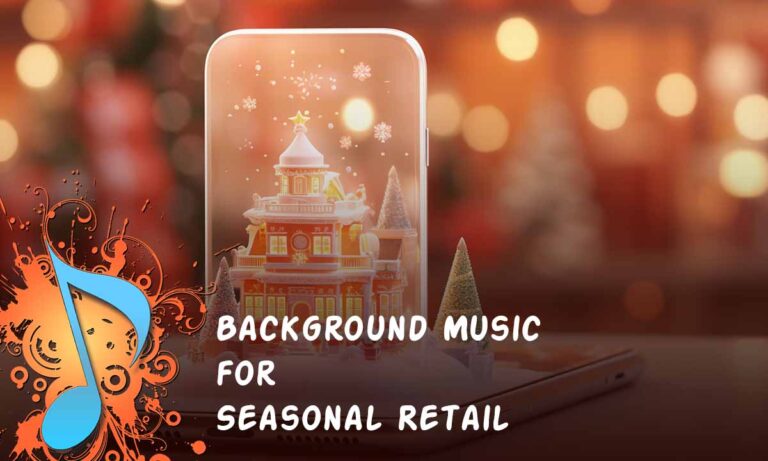In the field of retail, the significance of music is evident especially in the customer experience. Music has the ability to elicit an emotional response, set a mood, and even persuade customers to make a purchase.
Seasonal retail marketing has a few limitations because it is time-bound and creates anticipation, hence, there is a need to be selective on the chosen music. This promotes a more enjoyable shopping experience to customers leading to increased sales.
The Psychology of Music in Retail
Music is one of the tools that can change the vibe or sometimes the psyche of people be it positively or negatively. It has even been disseminated that it has the capacity to alter our mood, the rhythm of one’s activities, or even the amount of money spent within a day.

If used appropriately, music can also bring about the feeling of nostalgia, make one feel excited, or even relaxed, which are all factors that can enhance the effectiveness of the shopping process.
- Mood Creation: The choice of music played in a retail environment has vital implications on the mood of the surroundings. Fast and encouraged tunes lead audiences into excitement and creates a sense of hurry, whereas sad, calm connotations create room for reflection and meditation.
- Pace control: Furthermore, music can commandeer the pace that prevails in a shopping environment. Up-tempo background beats lead to customers moving through the store quicker while molasses slow down the customer and help them wish to explore more.
- Brand Association: Music can be employed in enhancing an existing or desired image. Use of the particular tune or a genre of music helps retailers in the building of their brand through music strategies that the target audience embraces.
Must Read:
Background Music in Retail: How Stores Use Music to Drive Sales
Copyrighted vs Royalty-Free Background Music: Understanding the Differences for Content Creators
Copyright Laws for Background Music: Guide for Content Creators
Customizing Background Music For Seasonal Shoppers
When deciding on music to be used for advertising purposes during a specific season, it is important to take into account the type of holiday or season being observed and the spirit of the occasion. Below are some of the suggestions regarding shopping tunes for holiday shoppers:

Holiday Themes:
- Christmas: In most cases, go for the classic Christmas carols, Christmas jingle bells and instrumental music of the holidays too.
- Halloween: Uses sound effects to heighten senses’ perception, many times opera singing, sinister questions and dark themed music are used.
- Valentine’s Day: Compose soft and warm romantic songs, ballads known for their love messages; Nurture such a romantic atmosphere.
- Easter: There are also secular songs meant for this time and these songs have rhythms typical of the spring season, so select such songs.
- Diwali: This is particularly true when playing such festive Indian music focused on drums and the traditional ones.
- Holi: Play surprisingly vibrant and cheerful music to enhance the atmosphere of the festival.
- Eid-ul-Fitr: The music of choice is peaceful and meditative observing the essence of Ramadan.
- Eid-ul-Adha: The music should be soft but with a somber character, as suited for the day’s events.
Emotional Resonance:
- Nostalgia: Evoke past era memories of the holidays from people through the use of bygone tunes or popular songs.
- Excitement: Foster the emotions of the season by utilizing upbeat, lively music that makes one look forward to the holiday season.
- Relaxation: Help the listeners relieve themselves of stress through peaceful tunes and easy orchestration.
Cultural Sensitivity:
- Diversity: Recognize the existence of these cultural traits and do not include music that would be considered disrespectful or unsuitable for specific ethnicities.
- Inclusivity: Select, those suitable music that embraces and accommodates the spirit of the holiday season in as many people as possible.
Volume and Variety:
- Volume Control: Place the music at reasonable levels suitable for the environment. Excessive levels of music make all too much sound displeasing while levels too far below requisite make the sound hard to hear.
- Variety: Develop a song list that is random in selection to enable clientele to stay on the section longer, and not get bored.
Customer Age-Breakdown:
- Age: Take into account the target age of the audience you intend to play the music for. Younger shoppers can be expected to lean towards modern tunes while older ones are likely to appreciate oldies.
- Preferences: Take note of what the customers say and what they would want so that you may identify what kind of music suits the customers best.

Exemplars: Campaigns oriented towards holiday music – Case Studies
Many retail chain stores have efficiently incorporated music as a marketing tool for various holidays. In particular:
- Starbucks: It has become a custom for Starbucks to play holiday music during the festive season and this includes Christmas songs and new holiday music. This has contributed in making their shops warm and welcoming especially during winters.
- Target: During the course of the year, whenever there are holidays, Target focuses on incorporating music that will meet the holiday theme and enhance the shopping experience. For instance when it is Halloween, the store plays ghostly sounds and eerie music.
Example Music:
Retailers are able to enhance the auditory and video appeal of seasonal retail campaigns by including and fine-tuing the background music to suit the season. Passionate feelings can be generated, torrent angles, create solid attachment to a brand and sales will respond favorably for music is one of the greatest marketing tool.
FAQs
How can I choose the right background music for my seasonal retail campaign?
Consider the holiday or season, desired emotions, cultural sensitivity, volume, variety, and customer demographics.
What are some popular holiday themes for background music?
Christmas: Classic carols, festive jingles, instrumental renditions.
Halloween: Eerie sound effects, haunting melodies, suspenseful music.
Valentine’s Day: Romantic ballads, love songs, soft instrumental pieces.
Easter: Cheerful, upbeat music with a springtime theme.
Diwali: Festive Indian music with percussion and traditional instruments.
Holi: Upbeat, colorful music reflecting the joyful spirit.
Eid-ul-Fitr: Calming, reflective music.
Eid-ul-Adha: Solemn, reflective music.
How can I use music to create a strong brand association?
Consistently use the same music or style of music in your stores to establish a unique brand identity and create a memorable shopping experience.




